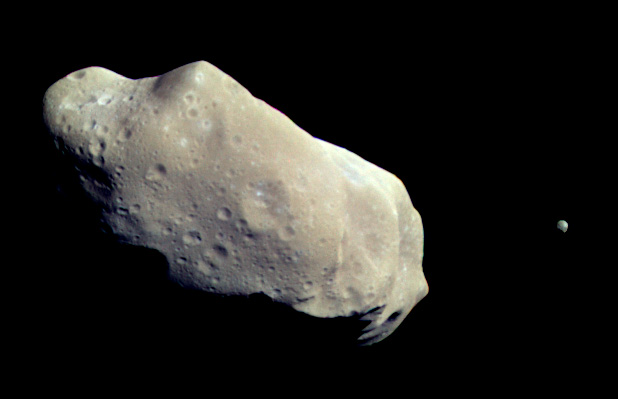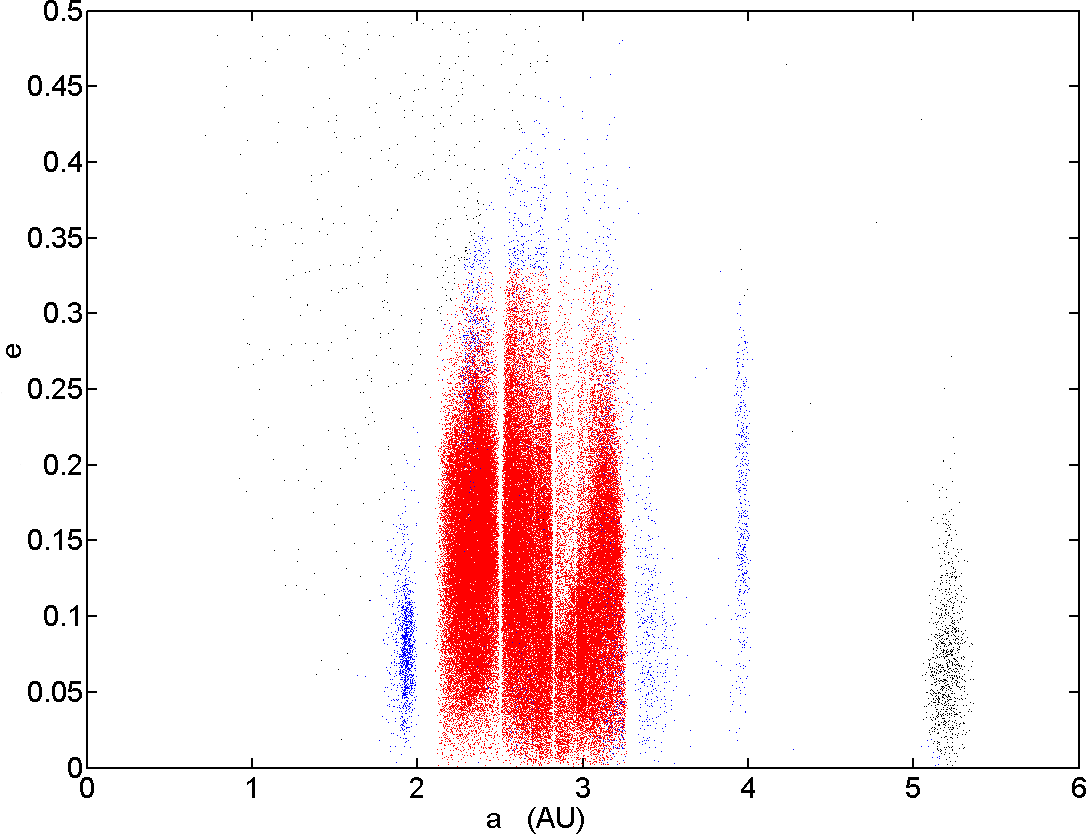|
2131 Mayall
2131 Mayall (1975 RA) is an inner main-belt asteroid discovered on September 3, 1975, by Arnold Klemola at the Lick Observatory and named in honor of Nicholas U. Mayall (1906–1993), director of the Kitt Peak National Observatory during 1960–1971, who also worked at Lick for many years. It is about 8 km (~5 miles) in diameter. Photometric measurements of the asteroid made in 2005 at the Palmer Divide Observatory showed a light curve with a period of 2.572 ± 0.002 hours and a brightness variation of 0.08 ± 0.02 in magnitude. This led to a follow-up investigation in 2006, when another light curve was recorded. These observations did not indicate a binary asteroid type, but did add to the data set available for this asteroid; this asteroid is part of the Hungaria group. See also *Nicholas U. Mayall Telescope The Nicholas U. Mayall Telescope, also known as the Mayall 4-meter Telescope, is a four-meter (158 inches) reflector telescope located at the Kitt Peak Nati ... [...More Info...] [...Related Items...] OR: [Wikipedia] [Google] [Baidu] |
Arnold Richard Klemola
This is a list of minor-planet discoverers credited by the Minor Planet Center with the discovery of one or several minor planets (such as near-Earth and main-belt asteroids, Jupiter trojans and distant objects). , the discovery of 612,011 numbered minor planets are credited to 1141 astronomers and 253 observatories, telescopes or surveys ''(see )''. On how a discovery is made, ''see observations of small Solar System bodies. For a description of the tables below, see ''. Discovering astronomers }, (bio-de) , align=left , M. Matsuyama , , - id="D. Matter" , align=left , Daniel Matter , 7 , 1957–pres. , , align=left , D. Matter; amateur, (bio-it) , align=left , D. Matter , , - id="A. Maury" , align=left , Alain Maury , 9 , 1958–pres. , , align=left , A. Maury; , align=left , A. Maury , , - id="D. Mayes" , align=left , Deronda Mayes , , 1957–pres. , , align=left , D. Mayes; inferred , align=left , D. Mayes , , - id="E. Mazzon ... [...More Info...] [...Related Items...] OR: [Wikipedia] [Google] [Baidu] |
Asteroid
An asteroid is a minor planet of the Solar System#Inner solar system, inner Solar System. Sizes and shapes of asteroids vary significantly, ranging from 1-meter rocks to a dwarf planet almost 1000 km in diameter; they are rocky, metallic or icy bodies with no atmosphere. Of the roughly one million known asteroids the greatest number are located between the orbits of Mars and Jupiter, approximately 2 to 4 astronomical unit, AU from the Sun, in the main asteroid belt. Asteroids are generally classified to be of three types: C-type asteroid, C-type, M-type asteroid, M-type, and S-type asteroid, S-type. These were named after and are generally identified with carbonaceous, metallic, and silicaceous compositions, respectively. The size of asteroids varies greatly; the largest, Ceres (dwarf planet), Ceres, is almost across and qualifies as a dwarf planet. The total mass of all the asteroids combined is only 3% that of Earth's Moon. The majority of main belt asteroids follow slig ... [...More Info...] [...Related Items...] OR: [Wikipedia] [Google] [Baidu] |
S-type Asteroids (Tholen)
S-type asteroids are asteroids with a spectral type that is indicative of a siliceous (i.e. stony) mineralogical composition, hence the name. They have relatively high density. Approximately 17% of asteroids are of this type, making it the second most common after the carbonaceous C-type. Characteristics S-type asteroids, with an astronomical albedo of typically 0.20, are moderately bright and consist mainly of iron- and magnesium- silicates. They are dominant in the inner part of the asteroid belt within 2.2 AU, common in the central belt within about 3 AU, but become rare farther out. The largest are 3 Juno (about 240–250 km across) and 15 Eunomia (230 km), with other large S-types being 29 Amphitrite, 532 Herculina and 7 Iris. These largest S-types are visible in 10x50 binoculars at most oppositions; the brightest, 7 Iris, can occasionally become brighter than +7.0, which is a higher magnitude than any asteroid except the unusually reflective 4 Vest ... [...More Info...] [...Related Items...] OR: [Wikipedia] [Google] [Baidu] |
Binary Asteroids
A binary asteroid is a system of two asteroids orbiting their common barycenter. The binary nature of 243 Ida was discovered when the Galileo spacecraft ''Galileo'' was an American robotic space probe that studied the planet Jupiter and its moons, as well as the asteroids Gaspra and Ida. Named after the Italian astronomer Galileo Galilei, it consisted of an orbiter and an entry probe. It was ... flew by the asteroid in 1993. Since then numerous binary asteroids and several triple asteroids have been detected. The mass ratio of the two components – called the "primary" and "secondary" of a binary system – is an important characteristic. Most binary asteroids have a large mass ratio, i.e. a relatively small satellite in orbit around the main component. Systems with a small minor-planet moon – also called "companion" or simply "satellite" – include 87 Sylvia, 107 Camilla, 45 Eugenia, 121 Hermione, 130 Elektra, 22 Kalliope, 28 ... [...More Info...] [...Related Items...] OR: [Wikipedia] [Google] [Baidu] |
Named Minor Planets
Named may refer to something that has been given a name. Named may also refer to: * named (computing), a widely used DNS server * Naming (parliamentary procedure) Naming is a procedure in some Westminster parliaments that provides for the speaker to temporarily remove a member of parliament who is breaking the rules of conduct of the legislature. Historically, "naming" refers to the speaker's invocation of ... * The Named (band), an American industrial metal group In literature: * '' The Named'', a fantasy novel by Marianne Curley * The Named, a fictional race of prehistoric big cats, depicted in '' The Books of the Named'' series by Clare Bell See also * Name (other) * Names (other) * Naming (other) {{disambiguation ... [...More Info...] [...Related Items...] OR: [Wikipedia] [Google] [Baidu] |
Discoveries By Arnold Klemola
Discoveries may refer to: Music * ''Discoveries'' (Cannonball Adderley album), 1955 * ''Discoveries'' (Josh Nelson album), 2011 * ''Discoveries'' (Northlane album), 2011 Other uses * ''Discoveries'' (film), a 1939 British film * Discoveries (horse), a racehorse * ''Discoveries'' (Robertson Davies), a 2002 book by Robertson Davies * ''Discoveries'' (TV series), a Canadian youth science television series which aired on CBC Television in 1957 * ''Abrams Discoveries'', a series of illustrated non-fiction books published by Harry N. Abrams * ''Discoveries'', a work by William Butler Yeats, written in 1907 * ''Discoveries'', a magazine published by Cedars-Sinai Medical Center See also * Age of Discoveries * Discovery (other) * Explorations (other) Explorations may refer to: *The plural of exploration Exploration refers to the historical practice of discovering remote lands. It is studied by geographers and historians. Two major eras of exploration occu ... [...More Info...] [...Related Items...] OR: [Wikipedia] [Google] [Baidu] |
Hungaria Asteroids
The Hungaria asteroids, also known as the Hungaria group, are a dynamical group of asteroids in the asteroid belt which orbit the Sun with a semi-major axis (longest radius of an ellipse) between 1.78 and 2.00 astronomical units (AU). They are the innermost dense concentration of asteroids in the Solar System—the near-Earth asteroids are much more sparse—and derive their name from their largest member 434 Hungaria. The Hungaria group includes the Hungaria family (), a collisional asteroid family which dominates its population. Description The Hungaria asteroids typically share the following orbital parameters: * Semi-major axis between 1.78 and 2.00 AU * Orbital period of approximately 2.5 years * Low eccentricity of below 0.18 * An inclination of 16° to 34° * Approximate mean-motion resonance with Jupiter of 9:2, and with Mars of 2:3 The 4:1 resonance Kirkwood gap (at 2.06 AU) marks the outer boundary of the Hungaria family, while interactions with Mars determine the ... [...More Info...] [...Related Items...] OR: [Wikipedia] [Google] [Baidu] |
Brian D
Brian (sometimes spelled Bryan in English) is a male given name of Irish and Breton origin, as well as a surname of Occitan origin. It is common in the English-speaking world. It is possible that the name is derived from an Old Celtic word meaning "high" or "noble". For example, the element ''bre'' means "hill"; which could be transferred to mean "eminence" or "exalted one". The name is quite popular in Ireland, on account of Brian Boru, a 10th-century High King of Ireland. The name was also quite popular in East Anglia during the Middle Ages. This is because the name was introduced to England by Bretons following the Norman Conquest. Bretons also settled in Ireland along with the Normans in the 12th century, and 'their' name was mingled with the 'Irish' version. Also, in the north-west of England, the 'Irish' name was introduced by Scandinavian settlers from Ireland. Within the Gaelic speaking areas of Scotland, the name was at first only used by professional families of Ir ... [...More Info...] [...Related Items...] OR: [Wikipedia] [Google] [Baidu] |
Springer Berlin Heidelberg
Springer Science+Business Media, commonly known as Springer, is a German multinational publishing company of books, e-books and peer-reviewed journals in science, humanities, technical and medical (STM) publishing. Originally founded in 1842 in Berlin, it expanded internationally in the 1960s, and through mergers in the 1990s and a sale to venture capitalists it fused with Wolters Kluwer and eventually became part of Springer Nature in 2015. Springer has major offices in Berlin, Heidelberg, Dordrecht, and New York City. History Julius Springer founded Springer-Verlag in Berlin in 1842 and his son Ferdinand Springer grew it from a small firm of 4 employees into Germany's then second largest academic publisher with 65 staff in 1872.Chronology ". Springer Science+Business Media. In 1964, Springer expanded its business internationally, o ... [...More Info...] [...Related Items...] OR: [Wikipedia] [Google] [Baidu] |
Jet Propulsion Laboratory
The Jet Propulsion Laboratory (JPL) is a federally funded research and development center and NASA field center in the City of La Cañada Flintridge, California, United States. Founded in the 1930s by Caltech researchers, JPL is owned by NASA and managed by the nearby California Institute of Technology (Caltech). The laboratory's primary function is the construction and operation of planetary robotic spacecraft, though it also conducts Earth-orbit and astronomy missions. It is also responsible for operating the NASA Deep Space Network. Among the laboratory's major active projects are the Mars 2020 mission, which includes the '' Perseverance'' rover and the '' Ingenuity'' Mars helicopter; the Mars Science Laboratory mission, including the '' Curiosity'' rover; the InSight lander (''Interior Exploration using Seismic Investigations, Geodesy and Heat Transport''); the ''Mars Reconnaissance Orbiter''; the '' Juno'' spacecraft orbiting Jupiter; the '' SMAP'' satellite for earth ... [...More Info...] [...Related Items...] OR: [Wikipedia] [Google] [Baidu] |
Hungaria Group
The Hungaria asteroids, also known as the Hungaria group, are a dynamical group of asteroids in the asteroid belt which orbit the Sun with a semi-major axis (longest radius of an ellipse) between 1.78 and 2.00 astronomical units (AU). They are the innermost dense concentration of asteroids in the Solar System—the near-Earth asteroids are much more sparse—and derive their name from their largest member 434 Hungaria. The Hungaria group includes the Hungaria family (), a collisional asteroid family which dominates its population. Description The Hungaria asteroids typically share the following orbital parameters: * Semi-major axis between 1.78 and 2.00 AU * Orbital period of approximately 2.5 years * Low eccentricity of below 0.18 * An inclination of 16° to 34° * Approximate mean-motion resonance with Jupiter of 9:2, and with Mars of 2:3 The 4:1 resonance Kirkwood gap (at 2.06 AU) marks the outer boundary of the Hungaria family, while interactions with Mars determine the ... [...More Info...] [...Related Items...] OR: [Wikipedia] [Google] [Baidu] |
Light Curve
In astronomy, a light curve is a graph of light intensity of a celestial object or region as a function of time, typically with the magnitude of light received on the y axis and with time on the x axis. The light is usually in a particular frequency interval or band. Light curves can be periodic, as in the case of eclipsing binaries, Cepheid variables, other periodic variables, and transiting extrasolar planets, or aperiodic, like the light curve of a nova, a cataclysmic variable star, a supernova or a microlensing event or binary as observed during occultation events. The study of the light curve, together with other observations, can yield considerable information about the physical process that produces it or constrain the physical theories about it. Variable stars Graphs of the apparent magnitude of a variable star over time are commonly used to visualise and analyse their behaviour. Although the categorisation of variable star types is increasingly done from t ... [...More Info...] [...Related Items...] OR: [Wikipedia] [Google] [Baidu] |

.jpg)




